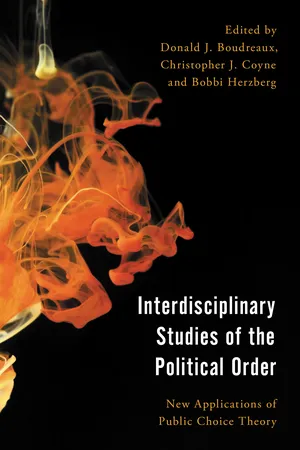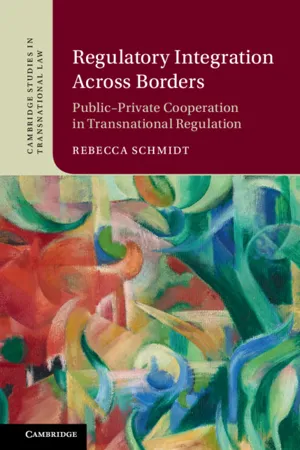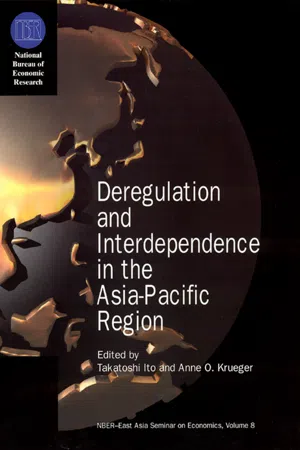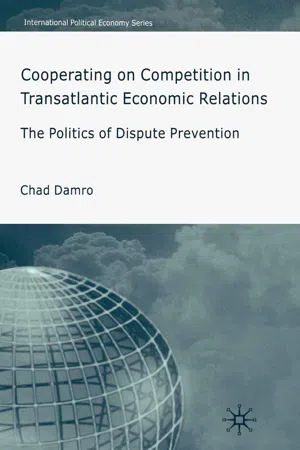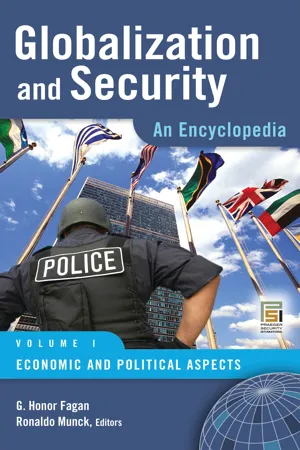Economics
International Regulatory Cooperation
International Regulatory Cooperation refers to the coordination and harmonization of regulations and standards across countries to facilitate international trade and investment. It involves the sharing of information, best practices, and technical expertise among regulatory agencies to ensure that regulations are effective, efficient, and consistent with international norms and standards.
Written by Perlego with AI-assistance
Related key terms
1 of 5
7 Key excerpts on "International Regulatory Cooperation"
- Gary Low(Author)
- 2022(Publication Date)
- Cambridge University Press(Publisher)
Hence there is a relationship between conflicts-cooperation-convergence. 4 International Regulatory Cooperation AND CONVERGENCE There is an increase of regulatory cooperation at the international level that involves states, international organizations, and private actors. 32 In their famous governance triangle, Abbott and Snidal provided the first taxonomy of different typologies of interactions between states, industry, and NGOs. 33 Since then, the debate on the public/private interactions and the drivers of conflicts and cooperation has bloomed, providing deeper and more comprehensive analyses. 34 International Regulatory Cooperation can take various forms and deploy different instruments. 35 In addition to the traditional forms of treaty-based and international 31 See below on the conflict between Amnesty and RSPO concerning the compliance by WILMAR with international labour standards. See Amnesty International, The great palm oil scandal: Labour abuses behind big brand names, Amnesty International, November 2016, available at www.amnestyinterna tional.org. 32 See OECD, International Regulatory Co-operation: Addressing Global Challenges (OECD Publishing, 2013). For a pioneering account, see G. Bermann, M. Herdegen, P. Lindseth, Transatlantic Regulatory Co-operation, Legal Problems and Political Prospects (Oxford University Press, 2000), and Vogel and Swinnen, Transatlantic Regulatory Cooperation: The Shifting Role of EU, US, and California (Edward Elgar, 2011). 33 From a wider perspective, see Abbott and Snidal, Governance triangle (n. 2). 34 B. Eberlein et al., Transnational business governance interactions: Conceptualisation and framework for analysis (2014) Regulation and Governance 1; Kingsbury and Stewart (eds.), Global Hybrid and Private Governance (Oxford University Press, 2017). 35 The OECD identifies eleven forms of IRC based on more than forty case studies. OECD, International Regulatory Co-operation: Case Studies, Vol.- eBook - PDF
Interdisciplinary Studies of the Political Order
New Applications of Public Choice Theory
- Donald J. Boudreaux, Christopher J. Coyne, Bobbi Herzberg, Donald J. Boudreaux, Christopher J. Coyne, Bobbi Herzberg(Authors)
- 2019(Publication Date)
- Rowman & Littlefield Publishers(Publisher)
International Regulatory Cooperation in particu-lar is often built on a sectoral basis and through a cooperative dialogue where states retain the ultimate authority in deciding whether they will participate or not. Furthermore, they argue that “outcomes will differ from those parties would have taken in autarky and reflect both economic interdependence and differences in values and institutional approaches” (16). In essence, the di-alogue fostered by regulatory cooperation can generate more sensitivity to different approaches. But whether or not regulatory cooperation is perceived as legitimate or democratic will largely depend on who gets to participate in this dialogue. A major challenge, as highlighted by Majone (1991), is that it is not easy to identify all dominant actors or “problem owners” so the community needs to be “sufficiently open and competitive so that interesting new ideas may emerge” (457). This is always going to be difficult to apply internationally, for the reasons mentioned earlier. For instance, what if some stakeholders simply have greater capacity to be heard? Will they play an outsized role in shaping international rules? In addition, it is important to keep in mind that Inu Manak 228 regulatory cooperation after the fact, that is once a rule is in place, is often very difficult to achieve. That is why there has been an increased focus on good regulatory practice and consultation at the earliest stage possible of regulatory development. However, this also poses a potential problem in that not all regulations can be notified in advance nor would it be politically feasible to allow interests outside of the state to comment. For instance, in the United States, draft legislation, unlike draft regula-tions, cannot be notified to the WTO. - eBook - PDF
Regulatory Integration Across Borders
Public–Private Cooperation in Transnational Regulation
- Rebecca Schmidt(Author)
- 2018(Publication Date)
- Cambridge University Press(Publisher)
6 Reassessing Cooperation 6.1 Introduction This book introduced regulatory cooperation at the transnational level. As manuals developed by international organisations to govern cooper- ation with the private sector and other public institutions illustrate, regulatory cooperation is a common phenomenon at the transnational level. The goal of this work was not only to raise awareness of the existence of regulatory cooperation but also to improve our understand- ing of the related theoretical implications for the transnational order. Regulatory cooperation, as defined in the previous chapters, links differ- ent issue areas and takes place between actors with distinctive origins, compositions and power. The case studies provided two examples for this: the ISO 26000 process, and cooperation at the intersection of sport and environmental regulation. On a more theoretical level, regulatory cooperation linked to debates about the transnational order and the allocation of authority beyond the state. One advantage of adopting a cooperative approach was that it enabled us to traverse institutional and conventional boundaries. This was particularly so regarding boundaries within legal scholarship. The book attempted to integrate – or perhaps more accurately to merge – literature on private authority and governance with the broader meta- framework discussion on the global legal order found in public law scholarship. 1 The sections that follow revisit the central arguments made in the book. These arguments concern, first, the commutative level and the resource exchange in which transnational regulators engage; and, second, the network structure which emerged, in which we may find stabilisation of values and thus constitutionalisation effects. This 1 Cf. H-W Micklitz, ‘Rethinking the Public/Private Divide’, in: M Maduro, K Tuori & S Sankari (eds), Transnational Law – Rethinking European Law and Legal Thinking (Cambridge University Press, 2014) 271, at 283. - Takatoshi Ito, Anne O. Krueger, Takatoshi Ito, Anne O. Krueger(Authors)
- 2007(Publication Date)
- University of Chicago Press(Publisher)
Mandatory economic analysis of regulatory policies is related to inter- national trade because it facilitates identifying whether regulations pro- mote efficiency or distort trade. An agreement among nations to use com- mon analytical methods for evaluating regulatory proposals drives regulation in each nation toward efficient policies and thereby reduces the distortions arising from regulations of different efficiency among nations. In this sense, adopting a common efficiency metric for domestic regulatory actions has the same role in reducing trade distortions as does a common agreement to reduce tariffs in that both reduce the wedge between actual prices and social costs of production. Moreover, agreement about meth- ods for evaluating regulations is a necessary component of a mechanism for resolving trade disputes over the ultimate purposes and effects of reg- ulations. In particular, a competent economic analysis can distinguish Regulatory Reform and International Trade Policy 45 regulations that have an anticompetitive purpose and distort trade from regulations that are efficient even though they have differential impacts on some imports. 1.6 International Regulatory Reform and Trade Until recently, the regulatory reform debate has been regarded primarily as an issue of domestic economic policy. As implied by the discussion of electronic commerce and of the trade distortions created by differences in regulatory efficiency among nations, a narrow, nationalistic view of regula- tory reform is not valid. As a result, recent trade negotiations and agree- ments inevitably have included provisions relating to regulatory issues. For example, the Uruguay Round led to an agreement that internal political constraints could not override principles of open access and created a WTO Committee on the Environment.'s Regulatory distortions take two conceptually distinct forms: domestic and international.- eBook - PDF
Declining International Cooperation on Pesticide Regulation
Frittering Away Food Security
- May T. Yeung, William A. Kerr, Blair Coomber, Matthew Lantz, Alyse McConnell(Authors)
- 2017(Publication Date)
- Palgrave Macmillan(Publisher)
Regulatory harmonization requires that the countries involved devise and agree on a common set of regulations that will apply in their respective jurisdictions. With regulatory differences removed, international trade will no longer be fettered by regulatory divergence. In the case of two countries, A and B, there are three possible paths to harmonization; (1) country B agrees to adjust its regulatory regime and adopts (harmonizes to) the regulatory regime of country A; (2) country A agrees to adjust its regulatory regime and adopts (harmonizes to) the reg- ulatory regime of country B; (3) both countries agree to adjust their cur- rent regulatory regimes and to devise a new common regulatory regime. Adjusting to a different regulatory regime will require firms and gov- ernments to incur costs—switching costs. In the first case above, all of the switching costs will be borne by firms and the government in coun- try B and none by country A. In the second case, all of the switching costs will be borne by firms and the government in country A and none by country B, while in the latter case, both country A and country B will have to bear some of the switching costs. Thus, countries have an incen- tive to negotiate hard to ensure that their existing standards become the common (harmonized) standard. Ongoing monitoring by both countries is prudent to ensure that its trading partner is enforcing the common regulatory regime with sufficient diligence. If regulations are harmo- nized, desired changes to regulations may be delayed by the need to negotiate the change with trading partners. In the case of the granting of equivalence, each country agrees to recognize the other county’s regulatory standard as satisfying its own 4 THE ECONOMICS OF INTERNATIONAL HARMONIZATION OF MRLS 29 regulatory requirements. - eBook - PDF
Cooperating on Competition in Transatlantic Economic Relations
The Politics of Dispute Prevention
- C. Damro(Author)
- 2006(Publication Date)
- Palgrave Macmillan(Publisher)
6 The Politics of International Regulatory Cooperation Introduction This study investigates a policy area in which EU-US cooperation excels - competition policy - in order to reveal and understand the causes of international cooperation. Examinations of transatlantic cooperation in competition policy are particularly informative for understanding the political, economic and legal dynamics of interna- tional relations more generally. Indeed, this case displays a useful synthesis of the political, economic and legal dynamics that motivate formal and informal efforts to enhance bilateral and multilateral governance. These dynamics are all the more important because they are occurring in a policy area that fundamentally organizes domestic economies but increasingly addresses cross-border activities. Due to the international importance of the EU-US relationship across a number of policy areas, a better understanding of transatlantic competition relations may provide crucial insights into the future modalities and organization of bilateral and multilateral governance more generally. This final chapter provides a brief recapitulation of the central puzzle and discusses the theoretical implications of the preceding analysis. Next, it summarizes the findings in terms of the patterns of behaviour for agents and principals. The chapter then comments on the role of business influences in EU-US cooperation in merger review, in particular, the potential ways in which to determine the role of firms in the intervention cost calculations of principals. The chapter concludes with a discussion of the generalizability of the findings to International Regulatory Cooperation in other policy areas. 150 The Politics of International Regulatory Cooperation 15 1 In particular, insights from this study are compared to the international politics of trade policy and the emerging political dynamics of coopera- tion in other areas characterized by increasing international regulation. - eBook - PDF
Globalization and Security
An Encyclopedia [2 volumes]
- G. Honor Fagan, Ronaldo Munck, G. Honor Fagan, Ronaldo Munck(Authors)
- 2009(Publication Date)
- Praeger(Publisher)
Consequently, studies have indicated that in the era of globalization, interna- tional organizations have collectively expanded their influence in the globaliza- tion of regulation, increasingly setting universal standards and administering regulatory instruments on an ever-widening range of issues (see Braithwaite and Drahos 2000, 486). Governments borrowing from international financial institutions, such as the World Bank or the IMF, also subject themselves to the regulatory jurisdictions of these organizations by accepting policy and regula- tory reforms in exchange for financing. The growing interdependence between states resulting from greater global integration has also created the need for their regulation at the international level to prevent the negative social, economic, and political cross-border exter- nalities associated with their unilateral action at the domestic level. For exam- ple, under the United Nations Framework Convention on Climate Change (UNFCC) and the Convention on Biological Diversity (CBD)—two multilateral environmental agreements aimed at combating the problems human activity has caused on the world’s ecology—state parties undertake commitments to reduce greenhouse gas emissions and conserve biological diversity within their jurisdictions. In this regard, states remain primary actors in the regulatory proc- ess, although regulation occurs at a supranational level. International agree- ments are negotiated and entered into by state organs, and the absence of such authority renders the obligations void under international law; consequently, states must undertake the responsibility to ensure that the obligations entered into are complied with within their national borders. Accession to international regulatory frameworks therefore means that the inter- nal policies of states will have to be consistent with state obligations under those regimes, compliance of which is monitored by the institutional focal point of each regime.
Index pages curate the most relevant extracts from our library of academic textbooks. They’ve been created using an in-house natural language model (NLM), each adding context and meaning to key research topics.

